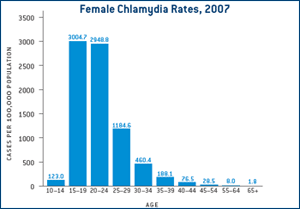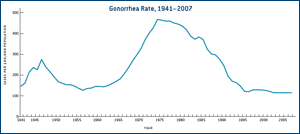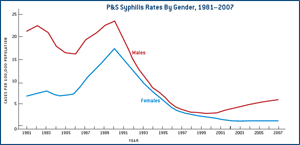
Trends in Reportable Sexually Transmitted Diseases in the United States, 2007
National Surveillance Data for Chlamydia, Gonorrhea, and Syphilis
Sexually transmitted diseases (STDs) remain a major public health challenge in the United States. CDC estimates that approximately 19 million new infections occur each year— almost half of them among young people 15 to 24 years of age1.
In addition to the burden on youth, women are also severely affected. Biological factors place women at greater risk than men for the severe health consequences of STDs. The two most commonly reported infectious diseases in America — chlamydia and gonorrhea — pose a particular risk to the health of women, as both can result in infertility if left untreated. Together, these diseases were reported in almost 1.5 million Americans in 2007, but the majority of cases continue to go undiagnosed.
Both of these diseases, along with syphilis and herpes, have also been associated with increased HIV transmission, which is of particular concern among men who have sex with men (MSM) of all races and African-American men and women, where the HIV burden is now greatest. Reducing the preventable and persistent toll of STDs will require expanded access to prevention, treatment, and screening services for the diverse populations now at risk.
This document summarizes 2007 national data on trends in three notifiable STDs — chlamydia, gonorrhea, and syphilis — that are published in CDC’s report, Sexually Transmitted Disease Surveillance 2007. These data, which are useful for examining overall trends and trends among specific populations at risk, represent only a small proportion of the true national burden of STDs. Many cases of notifiable STDs go undiagnosed, and some common viral infections, such as human papillomavirus and genital herpes, are not reported at all.
Chlamydia: Largest Number of Cases Reported to Date, Yet Majority of Infections Still Undiagnosed
Health Consequences of Chlamydia
Chlamydia is a bacterial infection that can easily be cured with antibiotics, but usually occurs without symptoms and often goes undiagnosed. Untreated, it can cause severe health consequences for women. Up to 40 percent of females with untreated chlamydia infections develop pelvic inflammatory disease (PID) – a condition, which can lead to such long-term complications as infertility, ectopic pregnancy, and chronic pelvic pain.2 Complications from chlamydia among men are relatively uncommon, but may include epididymitis and urethritis, which can cause pain, fever, and in rare cases, sterility. In addition, studies suggest that the presence of chlamydia infection increases the risk of HIV transmission.3
Chlamydia remains the most commonly reported disease in the United States. In 2007, 1,108,374 chlamydia diagnoses were reported, up from 1,030,911 in 2006. The 2007 total represents the largest number of cases ever reported to CDC for any condition. Even so, most chlamydia cases still go undiagnosed. CDC estimates that there are approximately 2.8 million new cases of chlamydia in the United States each year1, indicating that more than half of new cases remain undiagnosed and unreported.
The national rate of reported chlamydia in 2007 was 370.2 cases per 100,000 population, an increase of 7.5 percent from 2006 (344.3). Increases in chlamydia rates are more likely a reflection of the continued expansion of screening and use of more sensitive tests, rather than an increase in the total burden of the disease in the United States.
Severe Impact on Women, Especially Young and Minority Women
Women, especially young and minority women, are hit hardest by chlamydia. Studies have found that women are most severely impacted by the long-term consequences of untreated chlamydia.
The reported chlamydia case rate for females in 2007 was almost three times higher than for males (543.6 vs. 190.0 per 100,000 population). Much of this difference reflects the fact that females are far more likely to be screened than males. Young females 15 to 19 years of age had the highest chlamydia rate (3,004.7), followed by females 20 to 24 years of age (2,948.8). Chlamydia is common among all races and ethnic groups; however, African-American, American Indian/ Alaska Native, and Hispanic women are disproportionately affected. In 2007, black females 15 to 19 years of age had the highest chlamydia rate of any group (9,646.7), followed by black females 20 to 24 years of age (8,671.5). The rate of reported chlamydia per 100,000 black females overall (1,906.0) was almost eight times that of white females (249.3) and almost three times that of Hispanic females (753.3). The rate among American Indian/Alaska Native females was the second highest (1,158.2), while the rate among Asian/Pacific Islander females was the lowest (208.8).
Importance of Screening
Because chlamydia is most common among young women and is usually asymptomatic, CDC recommends annual chlamydia screening for all sexually active women under age 26, as well as older women with risk factors such as new or multiple sex partners.4 Data from one study in a managed care setting suggest that chlamydia screening and treatment can reduce the incidence of pelvic inflammatory disease (PID) by over 50 percent.5 Unfortunately, many sexually active young women are not being tested for chlamydia, in part reflecting a lack of awareness among some providers and limited resources for screening.6 Research has shown that simple changes in clinical procedures, such as coupling chlamydia tests with routine Pap testing, can sharply increase the proportion of women screened.7 Increased screening efforts are critical to preventing the serious health consequences of this infection, particularly infertility. While recent data suggest that chlamydia screening may be increasing, it is estimated that more than half of sexually active women under 26 were not screened within the last year.6
Reducing the impact of this disease among women will also require reducing and treating chlamydia among males. Recent studies have also shown that many young women who have been diagnosed with chlamydia may become re-infected by male partners who have not been diagnosed or treated.8, 9, 10 CDC’s 2006 STD Treatment Guidelines recommend that women be re-tested for chlamydia approximately three months after treatment, and also recommend that where possible, antibiotic therapy be delivered by heterosexual patients to their partners if other strategies for reaching and treating partners are not likely to succeed, an approach known as expedited partner therapy.4
Gonorrhea: Disease Stable but at Too High a Level
Gonorrhea is the second most commonly reported infectious disease in the United States, with 355,991 cases reported in 2007. Following a 74 percent decline in the rate of reported gonorrhea from 1975 through 1997, overall gonorrhea rates have remained relatively stable for the past decade, though the disease persists at too high a level. In 2007, the overall gonorrhea rate was 118.9 cases per 100,000 population, and rates were slightly higher among women (123.5) than among men (113.7). Like chlamydia, gonorrhea is substantially under-diagnosed and under-reported, and approximately twice as many new infections are estimated to occur each year as are reported.1
United States of Concern
As in previous years, in 2007 the South had the highest gonorrhea rate among the four regions of the country (156 cases per 100,000 population). Rates, while high in the South, have remained fairly stable.
While the impact is greatest in the South, public health officials have also been concerned in recent years about increases in gonorrhea rates in the West, with the reported rate of gonorrhea rising 17.1 percent between 2003 and 2007. Though the gonorrhea rate decreased slightly in the West from 2006 to 2007 (from 81.5 to 74.0 per 100,000 population), it is too early to determine if this indicates a reversal in the trend.
Between 2003 and 2007, the rate in the Northeast declined 15.1 percent (from 90.8 to 77.1) and the rate in the Midwest showed minimal change (from 135.8 in 2003 to 139.3 in 2007).
Additional Treatment Options Needed
Health Consequences of Gonorrhea
While gonorrhea is easily cured, untreated cases can lead to serious health problems similar to those caused by chlamydia. Among women, gonorrhea is a major cause of PID, which can lead to chronic pelvic pain, ectopic pregnancy, and infertility. In men, untreated gonorrhea can cause epididymitis, a painful infection in the tissue surrounding the testicles that can result in sterility. In addition, studies suggest that the presence of gonorrhea infection increases the likelihood of HIV transmission.3
Drug resistance is an important concern in the treatment and prevention of gonorrhea.11 CDC monitors trends in gonorrhea drug resistance through the Gonococcal Isolate Surveillance Project (GISP), which tests gonorrhea samples (isolates) from the first 25 men with urethral gonorrhea attending STD clinics each month in sentinel clinics across the United States (30 STD clinics and five regional labs participated in GISP in 2007).12
In April 2007, based on data showing widespread drug resistance to fluoroquinolones, a leading class of antibiotics used to treat gonorrhea, CDC revised its gonorrhea treatment guidelines, no longer recommending that this class of antibiotics be used to treat gonorrhea in the United States.13
With the loss of fluoroquinolones, recommended gonorrhea treatments are limited to a single class of antibiotics, cephalosporins. Although recent data show no indication of cephalosporin resistance in the United States, continued monitoring for emerging resistance is critical, and accelerated research into new treatments are needed to continue the nation’s progress in controlling this common sexually transmitted disease.
Syphilis: Cases Continue to Increase
The rate of primary and secondary (P&S) syphilis — the most infectious stages of the disease — decreased throughout the 1990s, and in 2000 reached an all-time low. However, over the past seven years, the syphilis rate in the United States has been increasing. Between 2006 and 2007, the national P&S syphilis rate increased 15.2 percent, from 3.3 to 3.8 cases per 100,000 population, and the number of cases increased from 9,756 to 11,466.
Increases Among Men Who Have Sex with Men Continue
The rate of P&S syphilis among men increased 17.9 percent in 2007 (from 5.6 per 100,000 in 2006 to 6.6 per 100,000 in 2007) . Since 2005, data reported to CDC has included gender of partners for persons with syphilis and in 2007, 65 percent of all P&S syphilis cases were among MSM, based on data from 44 states and the District of Columbia. Additionally, the disparity between male and female case rates has grown consistently. The P&S syphilis rate among males is now six times the rate among females, whereas the rates were almost equivalent a decade ago , suggesting that increases in men have largely been among men who sex with men.
Concerning Increases among Women and Infants
P&S syphilis rates remained substantially lower among females than males, though overall rates have increased each year among females since 2004, following more than a decade of declines. In 2007, the syphilis rate for females increased 10 percent (from 1.0 per 100,000 population in 2006 to 1.1 in 2007). This increase has occurred largely among black females, in whom rates rose 14.3 percent (from 4.9 in 2006 to 5.6 in 2007).
Additionally, the rate of congenital syphilis (i.e., transmission from mother to infant) increased for the second year in a row (from 9.3 per 100,000 live births in 2006 to 10.5 in 2007). Increases in congenital syphilis have historically followed increases among women.
Importance of Screening and Treatment
Syphilis, a genital ulcerative disease, is highly infectious, but easily curable in its early (primary and secondary) stages. If untreated, it can lead to serious long-term complications, including brain, cardiovascular, and organ damage, and even death. Untreated syphilis in pregnant women can also result in congenital syphilis (syphilis among infants), which can cause stillbirth, death soon after birth, and physical deformity and neurological complications in children who survive. Syphilis, like many other STDs, facilitates the spread of HIV by increasing the likelihood of transmission of the virus.14
CDC recommends that sexually active MSM be tested for syphilis, as well as chlamydia, gonorrhea, and HIV at least annually. To combat the increases in syphilis among MSM during the last decade, CDC has partnered with health departments and community groups in the cities hardest hit to implement new strategies for this population. These approaches range from new Internet-based strategies for notifying sexual partners to education campaigns targeted to high-risk populations and health care providers. As CDC continues to evaluate and work to replicate the most effective approaches to reducing this burden, it is clear that regular screening of MSM, especially HIV-positive MSM, remains one of the most critical steps toward preventing the spread of syphilis.
CDC also recommends that all pregnant women be screened for syphilis at the first prenatal visit. This is critical for protecting infants from the serious complications associated with congenital syphilis.
Racial Disparities Persist Across All Reportable STDs
Data in CDC’s 2007 STD surveillance report indicate persistent racial disparities in STD rates, with African Americans bearing a particularly heavy burden. Blacks represent only 12 percent of the total U.S. population, but made up about 70 percent of gonorrhea cases and almost half of all chlamydia and syphilis cases in 2007(48% and 46%, respectively). Similarly, disparities among Hispanics, though less severe, also exist for chlamydia. While Hispanics account for 15 percent of the U.S. population, they account for 19 percent of all reported chlamydia cases.
These disparities may be, in part, because racial and ethnic minorities are more likely to seek care in public health clinics that report STDs more completely than private providers. However, this reporting bias does not fully explain these differences. Socioeconomic barriers to quality healthcare and STD prevention and treatment services have likely contributed to a higher prevalence and incidence of STDs among racial and ethnic minorities. Ensuring that minority communities have access to prevention, screening, treatment and partner services needed to improve health is critical to addressing these disparities.
Chlamydia
In 2007, the rate of chlamydia among blacks was more than eight times higher than the rate among whites (1,398.7 vs. 162.3 per 100,000 population). Additionally, the rates among American Indians/Alaska Natives (732.3) and Hispanics (473.2), were approximately five times and three times higher than whites, respectively. The rate among Asians/Pacific Islanders was 139.5 per 100,000 population.
Gonorrhea
Racial disparities in gonorrhea rates are the most severe of all reportable STDs. The gonorrhea rate among blacks was 19 times greater than that of whites in 2007 (662.9 vs. 34.7 per 100,000 population). In 2007, there were declines in gonorrhea rates among all racial and ethnic groups, except blacks, among whom the gonorrhea rate increased by 1.8 percent between 2006 and 2007. In 2007, American Indians/Alaska Natives had the second-highest gonorrhea rate (107.1), followed by Hispanics (69.2), whites (34.7), and Asians/Pacific Islanders (18.8).
Syphilis
In 2007, the syphilis rate among blacks was seven times higher than that of whites (14.0 per 100,000 population as compared with 2.0). While this represents a substantial decline from 1999, when the rate among blacks was 29 times greater than among whites, significant disparities remain.
In 2007, the P&S syphilis rate among blacks increased for the fourth consecutive year, following more than a decade of declines. Between 2006 and 2007, the rate among blacks increased 25 percent (from 11.2 to 14.0 per 100,000 population), with the largest increase among black males (18.1 to 23.2, an increase of 28.2 percent). By comparison, the rate among black females increased 14.3 percent (4.9 to 5.6). In 2007, the rate of P&S syphilis in black females was 14 times higher than that of white females (5.6 as compared with 0.4 cases per 100,000).
Syphilis rates increased for all races and ethnicities in 2007, with the exception of Asians/Pacific Islanders, among whom the rate remained stable. The syphilis rate among Hispanics and American Indians/Alaska Natives increased 22.9 percent and 6.3 percent respectively between 2006 and 2007.
Intensified Efforts Needed to Address Significant Gaps in STD Prevention
To reduce the toll of STDs and protect the health of millions of Americans, expanded prevention efforts are urgently needed. In addition to the threat of infertility, increased risk of HIV acquisition and other health risks, STDs have a substantial economic impact. CDC estimates STDs cost the U.S. healthcare system as much as $15.3 billion annually in 2007 dollars.1, 15
CDC supports a comprehensive approach to STD prevention that includes expanded screening, treatment, and behavioral interventions, with a focus on reducing racial disparities.
In addition to recommending annual chlamydia screening for all sexually active women under 26 years of age, CDC also supports U.S. Preventive Services Task Force recommendation to screen high-risk, sexually active women for gonorrhea.
To further progress against chlamydia, CDC, the Partnership for Prevention and eight other national organizations, established the National Chlamydia Coalition. The partnership is comprised of non-profit organizations, health care professional associations, advocacy groups, health insurers, and government representatives working together to reduce the rates of chlamydia and its harmful effects among sexually active adolescent and young adults, to raise awareness of the importance of chlamydia screening to sexual health, and to help improve adherence to recommended screening guidelines.
Eliminating syphilis as a health threat in the United States will also require an increased commitment to education, testing, and treatment in all populations affected. While the disease was on the verge of elimination in the late 1990s, shifts in disease transmission have since resulted in substantial new prevention challenges. While elimination efforts were originally targeted to heterosexuals in the geographic areas where syphilis was concentrated, increases in syphilis among MSM across the country have since required that limited resources be shifted to combat two distinct syphilis epidemics. As a result, declines in reported syphilis cases in some areas and populations continue to be offset by syphilis increases in others. Ultimately, successful elimination of this disease will require intensified efforts at the federal, state, and local levels to reach the diverse and expanded populations now at risk.
References
1 Weinstock H, et al. Sexually transmitted diseases among American youth: incidence and prevalence estimates, 2000. Perspectives on Sexual and Reproductive Health 2004;36(1):6-10.
2 Hillis SD and Wasserheit JN. Screening for Chlamydia — A Key to the prevention of pelvic inflammatory disease. New England Journal of Medicine 1996;334(21):1399-1401.
3 Fleming DT and Wasserheit JN. From epidemiological synergy to public health policy and practice: the contribution of other sexually transmitted diseases to sexual transmission of HIV infection. Sexually Transmitted Infections 1999;75:3-17.
4 CDC. Sexually transmitted diseases treatment guidelines, 2006. Morbidity and Mortality Weekly Report 2006;55(RR-11).
5 Scholes D et al. Prevention of pelvic inflammatory disease by screening for cervical chlamydial infection. ![]() New England Journal of Medicine 1996;334(21):1362-1366.
New England Journal of Medicine 1996;334(21):1362-1366.
6 National Committee for Quality Assurance. ![]() The State of Health Care Quality 2008. Washington, D.C., 2008.
The State of Health Care Quality 2008. Washington, D.C., 2008.
7 Burstein G et al. Chlamydia screening in a health plan before and after a national performance measure introduction. Obstetrics & Gynecology 2005;106(2):327-334.
8 Whittington et al. Determinants of persistent and recurrent chlamydia trachomatis infection in young women: results of a multicenter cohort study. Sexually Transmitted Diseases 2001;28(2):117-123.
9 Reitmeijer CA et al. Incidence and repeat infection rates of chlamydia trachomatis among male and female patients in an STD clinic: implications for screening and rescreening. Sexually Transmitted Diseases 2002; 29(2):65-72.
10 Anschuetz et al. Determining risk markers for gonorrhea and chlamydial infection and reinfection among adolescents in public high schools. Sexually Transmitted Diseases 2009;36(1):4-8.
11 CDC. Increases in fluoroquinolone-resistant Neisseria gonorrhoeae among men who have sex with men — United States, 2003, and revised recommendations for gonorrhea treatment, 2004. Morbidity and Mortality Weekly Report 2004;53(16):335-338.
12 CDC. Gonococcal Isolate Surveillance Project.
13 CDC. Update to CDC’s Sexually Transmitted Diseases Treatment Guidelines, 2006: Fluoroquinolones No Longer Recommended for Treatment of Gonococcal Infections. Morbidity and Mortality Weekly Report 2007;56(14):332-336.
14 CDC. HIV prevention through early detection and treatment of other sexually transmitted diseases — United States recommendations of the Advisory Committee for HIV and STD Prevention. Morbidity and Mortality Weekly Report 1998; 47(RR-12):1-24.
15 Chesson HW, et al. The estimated direct medical cost of sexually transmitted diseases among American youth, 2000. Perspectives on Sexual and Reproductive Health 2004, 36(1): 11-19.
![]() Non-CDC Link Disclaimer: Links to non-Federal organizations found at this site are provided solely as a service to our users. These links do not constitute an endorsement of these organizations or their programs by CDC or the Federal Government, and none should be inferred. The CDC is not responsible for the content of the individual organization web pages found at these links.
Non-CDC Link Disclaimer: Links to non-Federal organizations found at this site are provided solely as a service to our users. These links do not constitute an endorsement of these organizations or their programs by CDC or the Federal Government, and none should be inferred. The CDC is not responsible for the content of the individual organization web pages found at these links.
![]() Some links on this page require Adobe Reader.
Some links on this page require Adobe Reader.
- Page last reviewed: January 13, 2009
- Page last updated: January 13, 2009
- Content source: Centers for Disease Control and Prevention, Division of STD Prevention, National Center for HIV/AIDS, Viral Hepatitis, STD, and TB Prevention




